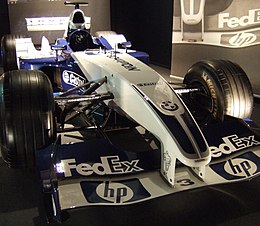Williams FW25
 |
|||||||||
| Category | Formula One | ||||||||
|---|---|---|---|---|---|---|---|---|---|
| Constructor | Williams | ||||||||
| Designer(s) |
|
||||||||
| Predecessor | FW24 | ||||||||
| Successor | FW26 | ||||||||
| Technical specifications | |||||||||
| Chassis | Carbon/Epoxy composite monocoque | ||||||||
| Suspension (front) | - | ||||||||
| Suspension (rear) | - | ||||||||
| Engine | BMW 2998cc V10 naturally aspirated Mid-mounted | ||||||||
| Transmission | Williams 7 - Speed longitudinal semi-automatic sequential | ||||||||
| Fuel | Petrobras | ||||||||
| Lubricants | Castrol | ||||||||
| Tyres | Michelin | ||||||||
| Competition history | |||||||||
| Notable entrants | BMW Williams F1 Team | ||||||||
| Notable drivers | 3. 4. 4. |
||||||||
| Debut | 2003 Australian Grand Prix | ||||||||
|
|||||||||
| Constructors' Championships | 0 | ||||||||
| Drivers' Championships | 0 | ||||||||
The Williams FW25 is a Formula One car designed by Williams and powered by a BMW V10 engine. The car was used by Williams for the 2003 championship. Three drivers would drive the FW25 in the 2003 season, with Marc Gené replacing regular racer Ralf Schumacher for the Italian Grand Prix after the German suffered a large testing accident testing at Monza's Lesmo 1 corner prior to that race. The other regular driver Juan Pablo Montoya started all of the season's Grand Prix.
The design of the 2003 Williams FW25 was a marked evolution over its predecessor, the Williams FW24, something that Williams had not done between 2001 and 2002. New to the 2003 design team was ex-Ferrari aerodynamicist, Antonia Terzi, who worked with existing designer Gavin Fisher after the departure of ex-chief aerodynamicist, Geoff Willis.
Although the car could have easily won its first Grand Prix during the Australian Grand Prix but for a costly spin by Colombian driver Juan Pablo Montoya, the car did not establish itself amongst the frontrunners on the grid until the Austrian Grand Prix where Montoya led before retiring with engine failure. Until that race, both drivers complained about understeer due to flaws in the car's design.
A new, wider front tyre introduced by Michelin at the Monaco Grand Prix unlocked the potential of the FW25, which would win that race, score a double-podium at the Canadian Grand Prix, then go on to score dominant 1-2 victories at the European Grand Prix at the Nürburgring, and the next race, the French Grand Prix at Magny-Cours.
...
Wikipedia
